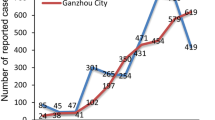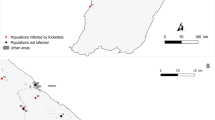Abstract
EPIDEMIC typhus is a severe rickettsial infection that classically has involved only man and his body louse. Although the aetiological agent, Rickettsia prowazekii, has been isolated from ticks of domestic animals and from blood of livestock in Ethiopia and Egypt1,2, infection of these unusual hosts and vectors has been thought to be secondary to active dissemination of the louse-borne disease in the human population3. Ormsbee concluded that livestock and the equivalent wild species were unlikely to be important in the ecology of epidemic typhus4. This disease was last reported in the eastern United States in Philadelphia in 1836 (ref. 5). We have now isolated six strains of R. prowazekii from the eastern flying squirrel (Glaucomys volans volans). This finding suggests that an extrahuman reservoir of epidemic typhus can exist in a species of wild rodent independent of the recent occurrence of epidemic or sporadic disease.
This is a preview of subscription content, access via your institution
Access options
Subscribe to this journal
Receive 51 print issues and online access
$199.00 per year
only $3.90 per issue
Buy this article
- Purchase on Springer Link
- Instant access to full article PDF
Prices may be subject to local taxes which are calculated during checkout
Similar content being viewed by others
References
Reiss-Gutfreund, R. J., Bull. Soc. Pathol. Exot., 49, 946–1021 (1956); ibid, 54, 284–297 (1961); Am. J. Trop. Med. Hyg., 15, 943–949 (1966).
Philip, C. B., and Imam, I. Z. E., in First Int. Conf. Vaccines against Viral and Rickettsial Diseases of Man, Washington DC 517–522 (PAHO/WHO, 1967).
Weiss, E. et al., Science, 159, 553–554 (1968).
Ormsbee, R. A., in The control of lice and louse-borne diseases, PAHO Publication No. 263, 104–109 (1973).
Gerhard, W. W., Am. J. med. Sci., 19, 289–322 (1837).
Riley, V., Proc. Soc. exp. Biol. Med., 104, 751–754 (1960).
Jackson, E. B., and Smadel, J. E., Am. J. Hyg., 53, 326–331 (1951).
Elisberg, B. L., and Bozeman, F. M., in Diagnostic procedures for viral and rickettsial infections, fourth ed. (edit. by Lennette, E. H.), 855 (American Public Health Association, New York, 1969).
Bozeman, F. M., Elisberg, B. L., Humphries, J. W., Runcik, K., and Palmer, D. B., Jr, J. Infect. Dis., 121, 367–371 (1970).
US Public Health Service Monogr. No. 74 (1968).
Author information
Authors and Affiliations
Rights and permissions
About this article
Cite this article
BOZEMAN, F., MASIELLO, S., WILLIAMS, M. et al. Epidemic typhus rickettsiae isolated from flying squirrels. Nature 255, 545–547 (1975). https://doi.org/10.1038/255545a0
Received:
Accepted:
Issue Date:
DOI: https://doi.org/10.1038/255545a0
This article is cited by
-
Fleas as parasites of the family Canidae
Parasites & Vectors (2011)
-
Emerging and re-emerging rickettsioses: endothelial cell infection and early disease events
Nature Reviews Microbiology (2008)
-
Häufigkeit des Frühsommer-Meningoenzephalitis-Virus und von Rickettsien in Zecken aus dem Burgenland (Österreich)
Wiener klinische Wochenschrift (2008)
-
Rickettsial Infections Around the World, Part 2: Rickettsialpox, the Typhus Group, and Bioterrorism
Journal of Cutaneous Medicine and Surgery (2005)
Comments
By submitting a comment you agree to abide by our Terms and Community Guidelines. If you find something abusive or that does not comply with our terms or guidelines please flag it as inappropriate.



